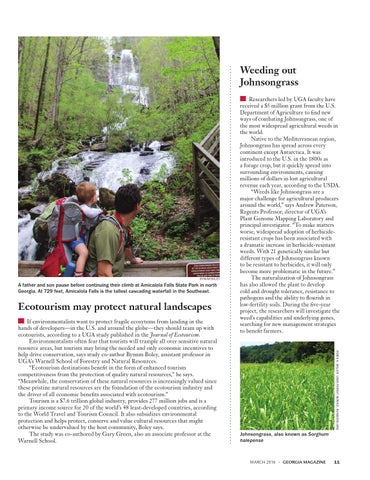Weeding out Johnsongrass
BYNUM BOLEY
A father and son pause before continuing their climb at Amicalola Falls State Park in north Georgia. At 729 feet, Amicalola Falls is the tallest cascading waterfall in the Southeast.
Ecotourism may protect natural landscapes
JAMES H. MILLER, USDA FOREST SERVICE, BUGWOOD.ORG
If environmentalists want to protect fragile ecosytems from landing in the hands of developers—in the U.S. and around the globe—they should team up with ecotourists, according to a UGA study published in the Journal of Ecotourism. Environmentalists often fear that tourists will trample all over sensitive natural resource areas, but tourism may bring the needed and only economic incentives to help drive conservation, says study co-author Bynum Boley, assistant professor in UGA’s Warnell School of Forestry and Natural Resources. “Ecotourism destinations benefit in the form of enhanced tourism competitiveness from the protection of quality natural resources,” he says. “Meanwhile, the conservation of these natural resources is increasingly valued since these pristine natural resources are the foundation of the ecotourism industry and the driver of all economic benefits associated with ecotourism.” Tourism is a $7.6 trillion global industry, provides 277 million jobs and is a primary income source for 20 of the world’s 48 least-developed countries, according to the World Travel and Tourism Council. It also subsidizes environmental protection and helps protect, conserve and value cultural resources that might otherwise be undervalued by the host community, Boley says. The study was co-authored by Gary Green, also an associate professor at the Warnell School.
Researchers led by UGA faculty have received a $5 million grant from the U.S. Department of Agriculture to find new ways of combating Johnsongrass, one of the most widespread agricultural weeds in the world. Native to the Mediterranean region, Johnsongrass has spread across every continent except Antarctica. It was introduced to the U.S. in the 1800s as a forage crop, but it quickly spread into surrounding environments, causing millions of dollars in lost agricultural revenue each year, according to the USDA. “Weeds like Johnsongrass are a major challenge for agricultural producers around the world,” says Andrew Paterson, Regents Professor, director of UGA’s Plant Genome Mapping Laboratory and principal investigator. “To make matters worse, widespread adoption of herbicideresistant crops has been associated with a dramatic increase in herbicide-resistant weeds. With 21 genetically similar but different types of Johnsongrass known to be resistant to herbicides, it will only become more problematic in the future.” The naturalization of Johnsongrass has also allowed the plant to develop cold and drought tolerance, resistance to pathogens and the ability to flourish in low-fertility soils. During the five-year project, the researchers will investigate the weed’s capabilities and underlying genes, searching for new management strategies to benefit farmers.
Johnsongrass, also known as Sorghum halepense
MARCH 2016 • GEORGIA MAGAZINE
11
